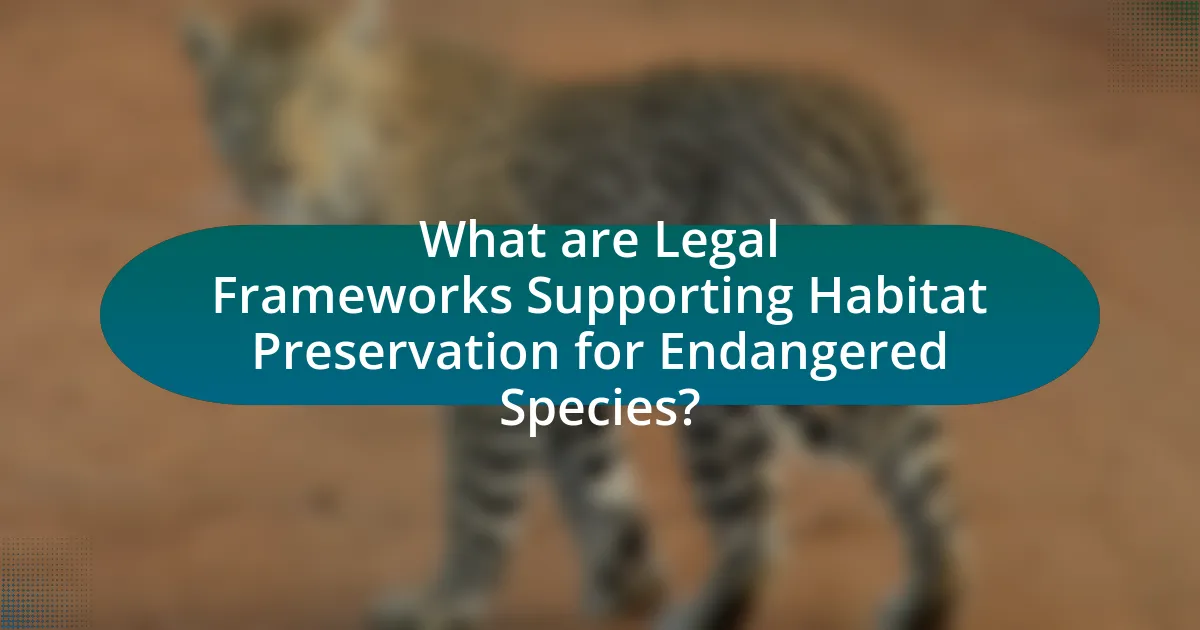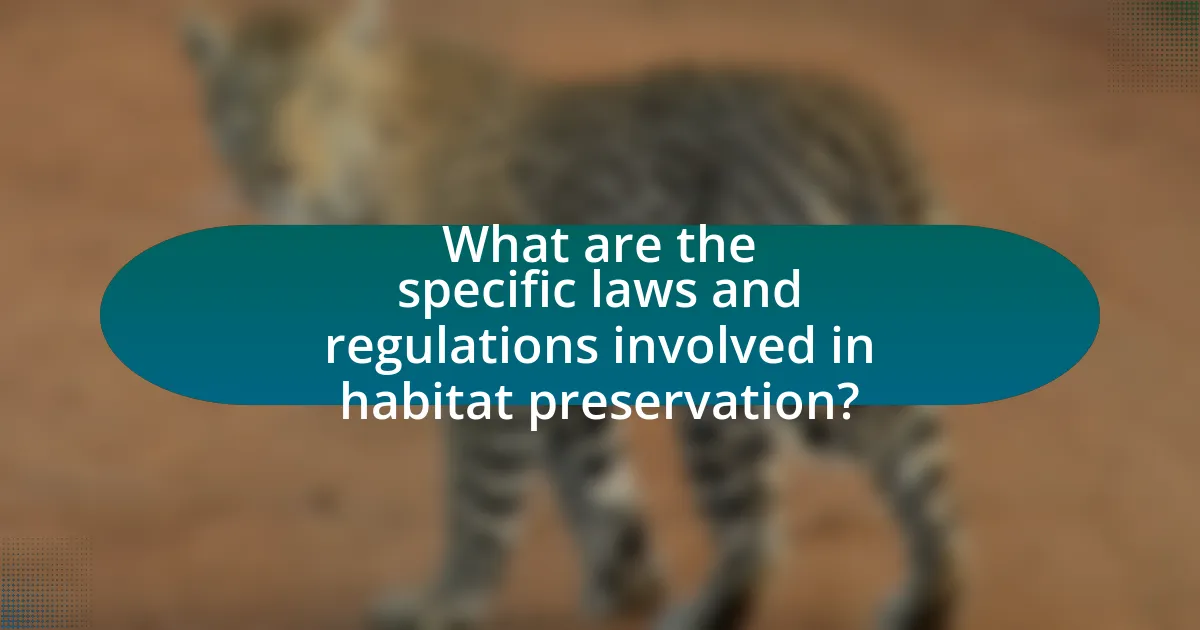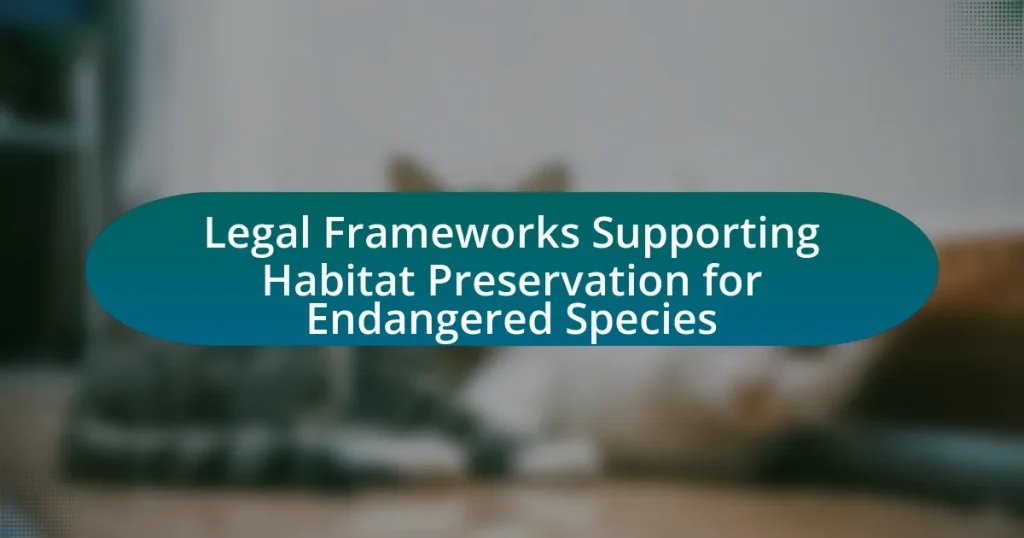Legal frameworks supporting habitat preservation for endangered species are essential for ensuring the survival of threatened species and their ecosystems. Key legal instruments include the Endangered Species Act (ESA) in the United States, the Convention on International Trade in Endangered Species (CITES), and the Biodiversity Convention. These frameworks establish regulations, enforcement mechanisms, and stakeholder engagement strategies that collectively protect critical habitats and promote conservation efforts. The article examines how these legal frameworks function in practice, their key components, and their impact on biodiversity conservation, while also addressing the challenges and successes of implementation. Additionally, it explores the role of technology and emerging trends in enhancing legal protections for endangered species amidst changing environmental conditions.

What are Legal Frameworks Supporting Habitat Preservation for Endangered Species?
Legal frameworks supporting habitat preservation for endangered species include the Endangered Species Act (ESA) in the United States, the Convention on International Trade in Endangered Species of Wild Fauna and Flora (CITES), and the Biodiversity Convention. The ESA, enacted in 1973, provides for the conservation of species that are endangered or threatened and their habitats, mandating federal agencies to ensure that their actions do not jeopardize these species. CITES, established in 1975, regulates international trade in endangered species to prevent exploitation that could threaten their survival. The Biodiversity Convention, adopted in 1992, aims to conserve biological diversity and promote sustainable use of its components, emphasizing the importance of habitat preservation. These legal frameworks collectively establish guidelines and protections that are crucial for the survival of endangered species and their habitats.
How do these legal frameworks function in practice?
Legal frameworks supporting habitat preservation for endangered species function through a combination of regulations, enforcement mechanisms, and stakeholder engagement. These frameworks establish legal protections for critical habitats, often designating specific areas as protected zones where development and resource extraction are restricted. For example, the Endangered Species Act in the United States mandates federal agencies to ensure that actions they authorize, fund, or carry out do not jeopardize the continued existence of listed species or destroy their critical habitats. Enforcement is typically carried out by governmental agencies, which monitor compliance and can impose penalties for violations. Additionally, these frameworks often involve collaboration with local communities, conservation organizations, and private landowners to promote habitat conservation efforts, thereby enhancing their effectiveness in practice.
What are the key components of these legal frameworks?
The key components of legal frameworks supporting habitat preservation for endangered species include legislation, regulatory mechanisms, enforcement provisions, and stakeholder engagement. Legislation, such as the Endangered Species Act in the United States, establishes legal protections for threatened and endangered species and their habitats. Regulatory mechanisms outline the processes for habitat designation, conservation planning, and permitting for activities that may impact these habitats. Enforcement provisions ensure compliance with the laws and regulations, often involving penalties for violations. Stakeholder engagement involves collaboration with local communities, conservation organizations, and governmental agencies to promote effective habitat preservation strategies. These components collectively create a structured approach to safeguarding endangered species and their ecosystems.
How do these components interact to support habitat preservation?
Legal frameworks, such as the Endangered Species Act, interact with conservation strategies and stakeholder engagement to support habitat preservation. These laws establish protections for endangered species and their habitats, mandating federal agencies to ensure that actions do not jeopardize these species. For example, the Act requires habitat conservation plans that involve collaboration between government entities, non-profit organizations, and private landowners, promoting a shared responsibility for habitat protection. This collaborative approach has led to successful recovery efforts, as seen in the case of the California condor, where legal protections facilitated habitat restoration and population growth. Thus, the interaction of legal frameworks, conservation strategies, and stakeholder involvement creates a comprehensive approach to habitat preservation.
Why are legal frameworks essential for endangered species?
Legal frameworks are essential for endangered species because they provide the necessary legal protections and regulations to prevent extinction and promote conservation efforts. These frameworks establish guidelines for habitat preservation, regulate hunting and trade, and enforce penalties for violations, thereby ensuring that endangered species receive the protection they need. For instance, the Endangered Species Act in the United States has successfully contributed to the recovery of several species, such as the American bald eagle, which was removed from the endangered species list due to effective legal protections and habitat restoration efforts.
What role do these frameworks play in biodiversity conservation?
Legal frameworks play a crucial role in biodiversity conservation by establishing regulations and guidelines that protect endangered species and their habitats. These frameworks, such as the Endangered Species Act in the United States, provide legal mechanisms for the identification, protection, and recovery of threatened species, ensuring that their ecosystems are preserved. For instance, the Act has led to the recovery of species like the American bald eagle and the gray wolf, demonstrating the effectiveness of legal protections in reversing declines in biodiversity.
How do they address the threats faced by endangered species?
Legal frameworks address the threats faced by endangered species through regulations that protect their habitats and impose penalties for violations. For example, the Endangered Species Act in the United States provides a legal basis for the conservation of threatened and endangered species and their ecosystems, mandating federal agencies to ensure that their actions do not jeopardize these species. Additionally, international agreements like the Convention on International Trade in Endangered Species (CITES) regulate trade to prevent exploitation that could lead to extinction. These frameworks are supported by scientific research and data, demonstrating their effectiveness in reducing threats such as habitat destruction and illegal poaching.
What types of legal frameworks exist for habitat preservation?
Various legal frameworks exist for habitat preservation, including national laws, international treaties, and local regulations. National laws, such as the Endangered Species Act in the United States, provide specific protections for threatened and endangered species and their habitats. International treaties, like the Convention on Biological Diversity, establish commitments among countries to conserve biodiversity and manage habitats sustainably. Local regulations often include zoning laws and land-use planning that aim to protect critical habitats at the community level. These frameworks collectively contribute to the conservation of ecosystems and the species that depend on them.
What are international treaties and agreements related to habitat preservation?
International treaties and agreements related to habitat preservation include the Convention on Biological Diversity (CBD), the Ramsar Convention on Wetlands, and the Convention on International Trade in Endangered Species of Wild Fauna and Flora (CITES). The CBD, established in 1992, aims to conserve biological diversity, promote sustainable use of its components, and ensure fair sharing of benefits arising from genetic resources. The Ramsar Convention, adopted in 1971, focuses on the conservation and sustainable use of wetlands, recognizing their critical role in biodiversity and ecosystem services. CITES, implemented in 1975, regulates international trade in endangered species to prevent their extinction, thereby indirectly supporting habitat preservation by protecting species that are integral to their ecosystems. These treaties collectively create a legal framework that supports habitat preservation efforts globally.
How do national laws and regulations contribute to habitat protection?
National laws and regulations contribute to habitat protection by establishing legal frameworks that govern land use, conservation practices, and species protection. These laws, such as the Endangered Species Act in the United States, provide mechanisms for designating critical habitats, regulating activities that may harm these habitats, and enforcing penalties for violations. For instance, the Endangered Species Act has led to the protection of over 1,900 species and the preservation of millions of acres of habitat, demonstrating the effectiveness of legal measures in safeguarding biodiversity.
How do legal frameworks impact conservation efforts?
Legal frameworks significantly impact conservation efforts by establishing regulations and protections for endangered species and their habitats. These frameworks, such as the Endangered Species Act in the United States, provide legal mechanisms to prevent habitat destruction, regulate hunting and trade, and promote recovery plans for at-risk species. For instance, the Endangered Species Act has led to the recovery of species like the American bald eagle, which was removed from the endangered list due to successful legal protections and habitat restoration efforts. Such laws create accountability and enforceable standards that guide conservation actions, ensuring that biodiversity is preserved and ecosystems are maintained.
What are the successes and challenges of implementing these frameworks?
The successes of implementing legal frameworks for habitat preservation of endangered species include increased protection of critical habitats, which has led to the recovery of certain species populations, such as the American bald eagle, whose numbers rose from fewer than 500 in the 1960s to over 300,000 today due to the Endangered Species Act. Additionally, these frameworks have facilitated collaboration among various stakeholders, including government agencies, conservation organizations, and local communities, enhancing conservation efforts.
However, challenges persist, such as insufficient funding for enforcement and management of protected areas, which can hinder effective implementation. Moreover, conflicts between economic development and conservation goals often arise, leading to legal disputes and delays in habitat protection. For instance, the designation of critical habitats can face opposition from industries like agriculture and real estate, complicating the enforcement of these legal frameworks.
How do legal frameworks influence public awareness and engagement?
Legal frameworks significantly influence public awareness and engagement by establishing regulations and guidelines that inform citizens about environmental protections and conservation efforts. For instance, laws such as the Endangered Species Act in the United States create a legal basis for the protection of endangered species and their habitats, which raises public consciousness about biodiversity issues. Additionally, these frameworks often mandate public participation in decision-making processes, such as environmental assessments, thereby fostering community involvement and advocacy. Research indicates that when legal protections are in place, public engagement in conservation initiatives increases, as seen in studies conducted by the World Wildlife Fund, which highlight the correlation between legal protections and community-led conservation efforts.

What are the specific laws and regulations involved in habitat preservation?
The specific laws and regulations involved in habitat preservation include the Endangered Species Act (ESA) of 1973, the National Environmental Policy Act (NEPA) of 1969, and the Clean Water Act (CWA) of 1972. The ESA provides a framework for the conservation of threatened and endangered species and their habitats, requiring federal agencies to ensure that actions do not jeopardize these species. NEPA mandates environmental assessments for federal projects, ensuring that potential impacts on habitats are considered. The CWA regulates discharges into waters, protecting aquatic habitats essential for various species. These laws collectively establish a legal basis for habitat preservation, supported by numerous case studies demonstrating their effectiveness in protecting biodiversity.
What is the Endangered Species Act and its significance?
The Endangered Species Act (ESA) is a U.S. law enacted in 1973 aimed at protecting species at risk of extinction and their habitats. Its significance lies in its role as a critical legal framework that facilitates the conservation of biodiversity by prohibiting the harming of listed species and designating critical habitats essential for their survival. The ESA has successfully led to the recovery of several species, such as the American bald eagle and the gray wolf, demonstrating its effectiveness in preserving wildlife and ecosystems.
How does the Endangered Species Act protect critical habitats?
The Endangered Species Act protects critical habitats by designating specific areas essential for the conservation of threatened and endangered species. This designation restricts activities that could harm these habitats, ensuring the survival and recovery of species. The Act mandates federal agencies to consult with the U.S. Fish and Wildlife Service before undertaking actions that may affect critical habitats, thereby enforcing protective measures. Additionally, the Act allows for the establishment of habitat conservation plans, which promote the recovery of species while balancing economic interests. These provisions are supported by the fact that habitat loss is a primary threat to biodiversity, making the protection of critical habitats vital for species survival.
What are the enforcement mechanisms of the Endangered Species Act?
The enforcement mechanisms of the Endangered Species Act (ESA) include civil and criminal penalties for violations, the ability for federal agencies to take action to protect endangered species, and the authority for citizens to file lawsuits against violators. The ESA empowers the U.S. Fish and Wildlife Service and the National Marine Fisheries Service to enforce regulations, which can lead to fines up to $50,000 for individuals and $200,000 for organizations, along with imprisonment for up to one year for criminal violations. Additionally, the Act allows for citizen suits, enabling individuals or organizations to sue for enforcement of the ESA, thereby enhancing accountability and compliance.
What role do state and local laws play in habitat preservation?
State and local laws are crucial in habitat preservation as they establish regulations and protections for ecosystems and endangered species within their jurisdictions. These laws can include zoning regulations, land use planning, and specific conservation measures that directly impact habitat quality and availability. For instance, the California Endangered Species Act provides legal protections for threatened and endangered species, influencing land development decisions to minimize habitat destruction. Additionally, local ordinances may create protected areas or wildlife corridors, further enhancing habitat preservation efforts. Such laws are essential for implementing conservation strategies that align with federal regulations, ensuring comprehensive protection for vulnerable species and their habitats.
How do state laws complement federal regulations?
State laws complement federal regulations by providing additional protections and specific guidelines tailored to local ecosystems and species. For instance, while the Endangered Species Act establishes a federal framework for protecting endangered species, state laws can impose stricter regulations, such as habitat conservation plans or local land-use restrictions, that enhance these protections. This dual-layered approach allows for more effective conservation efforts, as states can address unique environmental challenges and engage local communities in preservation initiatives, thereby reinforcing the overall objectives of federal regulations.
What are examples of successful local habitat preservation initiatives?
Successful local habitat preservation initiatives include the establishment of the Florida Everglades restoration project, which aims to restore and protect the unique ecosystem of the Everglades, a UNESCO World Heritage site. This initiative has received significant funding and support from both state and federal governments, resulting in improved water quality and habitat for numerous endangered species, such as the Florida panther and the American crocodile. Another example is the creation of the San Juan Islands Marine Conservation Area in Washington State, which protects critical marine habitats and has led to the recovery of local salmon populations. These initiatives demonstrate effective collaboration among government agencies, non-profit organizations, and local communities to achieve habitat preservation goals.
How do legal frameworks adapt to changing environmental conditions?
Legal frameworks adapt to changing environmental conditions by incorporating flexible regulatory mechanisms that allow for timely updates and revisions. For instance, many environmental laws include provisions for periodic review and amendment based on new scientific data or changing ecological circumstances, such as the Endangered Species Act in the United States, which has been amended to address emerging threats to species and habitats. Additionally, legal frameworks often integrate adaptive management practices, which enable stakeholders to respond to environmental changes through iterative decision-making processes, ensuring that conservation efforts remain effective in the face of evolving challenges.
What processes are in place for updating laws and regulations?
The processes for updating laws and regulations typically involve legislative review, public consultation, and regulatory impact assessments. Legislative bodies, such as Congress or state legislatures, propose amendments or new laws based on emerging scientific data, public needs, or environmental changes. Public consultations allow stakeholders, including conservation groups and local communities, to provide input, ensuring that diverse perspectives are considered. Regulatory impact assessments evaluate the potential effects of proposed changes, ensuring that updates are effective and aligned with conservation goals. These processes are essential for adapting legal frameworks to better support habitat preservation for endangered species, as evidenced by the Endangered Species Act, which has undergone revisions to enhance its effectiveness in protecting biodiversity.
How do scientific findings influence legal adaptations?
Scientific findings influence legal adaptations by providing empirical evidence that informs policy decisions and regulatory frameworks. For instance, research demonstrating the decline of specific endangered species due to habitat loss can lead to the enactment of stricter environmental laws aimed at habitat preservation. A notable example is the Endangered Species Act in the United States, which was influenced by scientific studies highlighting the critical status of various species and their ecosystems. These findings compel lawmakers to adapt legal measures that ensure the protection of biodiversity, thereby aligning legal frameworks with the latest scientific understanding of ecological needs.

What are the future trends in legal frameworks for habitat preservation?
Future trends in legal frameworks for habitat preservation include increased integration of biodiversity considerations into national and international laws, enhanced enforcement mechanisms, and the adoption of ecosystem-based management approaches. These trends are driven by the recognition of the interconnectedness of ecosystems and the need for comprehensive strategies to combat habitat loss. For instance, the Convention on Biological Diversity emphasizes the importance of protecting habitats as a means to preserve biodiversity, leading to stronger commitments from countries to implement protective measures. Additionally, the rise of climate change legislation is prompting legal frameworks to incorporate habitat preservation as a critical component of climate resilience strategies, ensuring that legal protections adapt to changing environmental conditions.
How is technology influencing habitat preservation laws?
Technology is significantly influencing habitat preservation laws by enabling more precise monitoring and data collection regarding endangered species and their habitats. Advanced tools such as satellite imagery, drones, and geographic information systems (GIS) allow for real-time tracking of habitat changes and species populations, which informs legislative decisions. For instance, the use of remote sensing technology has led to the identification of critical habitats that require legal protection, as seen in the implementation of the Endangered Species Act in the United States. Additionally, data analytics and machine learning are being utilized to predict the impacts of climate change on habitats, prompting lawmakers to adapt existing regulations to better protect vulnerable ecosystems.
What role do data and monitoring play in shaping legal frameworks?
Data and monitoring are crucial in shaping legal frameworks by providing evidence-based insights that inform policy decisions. Accurate data collection on species populations, habitat conditions, and threats enables lawmakers to understand the ecological context and urgency of conservation needs. For instance, the Endangered Species Act in the United States relies on scientific data to determine which species require protection and to assess the effectiveness of conservation measures. Monitoring programs, such as those conducted by the International Union for Conservation of Nature, track changes in biodiversity and habitat health, which directly influence legal protections and resource allocation. This data-driven approach ensures that legal frameworks are responsive to the actual conditions affecting endangered species and their habitats.
How can technology improve compliance and enforcement?
Technology can improve compliance and enforcement in habitat preservation for endangered species by enhancing monitoring capabilities and streamlining reporting processes. For instance, satellite imagery and drones enable real-time surveillance of protected areas, allowing authorities to detect illegal activities such as poaching or habitat destruction more effectively. A study by the World Wildlife Fund found that the use of drones increased the detection of illegal activities by up to 80% in certain regions. Additionally, mobile applications facilitate easier reporting of violations by citizens, which can lead to quicker responses from enforcement agencies. These technological advancements not only increase the efficiency of compliance efforts but also foster greater public engagement in conservation initiatives.
What are the emerging challenges for legal frameworks in habitat preservation?
Emerging challenges for legal frameworks in habitat preservation include the rapid pace of climate change, which complicates the establishment of effective conservation areas. Legal frameworks often struggle to adapt to shifting ecosystems and species distributions, as evidenced by the Intergovernmental Panel on Climate Change (IPCC) reports indicating that many species are migrating to higher altitudes and latitudes due to temperature increases. Additionally, the increasing fragmentation of habitats due to urban development and agricultural expansion poses significant legal hurdles, as existing laws may not adequately address the need for connectivity between habitats. Furthermore, the rise of new technologies, such as genetic engineering and synthetic biology, raises ethical and regulatory questions that current legal frameworks are ill-equipped to handle, potentially undermining traditional conservation efforts.
How do climate change and habitat loss impact legal protections?
Climate change and habitat loss significantly weaken legal protections for endangered species by altering ecosystems and diminishing biodiversity. As habitats become fragmented or degraded due to climate-related factors, the effectiveness of existing legal frameworks, such as the Endangered Species Act, is compromised, making it challenging to ensure the survival of vulnerable species. For instance, a study published in the journal “Conservation Biology” highlights that climate change can shift species’ ranges, leading to mismatches between their habitats and the legal protections intended to safeguard them. This results in increased difficulty for conservation efforts to adapt to rapidly changing environmental conditions, ultimately undermining the legal mechanisms designed to protect endangered species.
What are the implications of political changes on habitat preservation laws?
Political changes can significantly alter habitat preservation laws by shifting priorities and funding for environmental protection. For instance, when a government prioritizes economic development over conservation, it may weaken regulations that protect critical habitats, leading to increased habitat destruction. Historical examples include the rollback of the National Environmental Policy Act under certain administrations, which reduced the scrutiny of projects that could harm habitats. Additionally, changes in political leadership can result in the appointment of officials who may favor industry interests, further undermining habitat preservation efforts. These implications highlight the direct correlation between political dynamics and the effectiveness of laws designed to protect endangered species and their habitats.
What best practices can enhance the effectiveness of legal frameworks?
Best practices that can enhance the effectiveness of legal frameworks include stakeholder engagement, clear legal definitions, and adaptive management strategies. Stakeholder engagement ensures that the interests of all parties, including local communities and conservationists, are considered, leading to more comprehensive and accepted legal measures. Clear legal definitions provide unambiguous guidelines that facilitate enforcement and compliance, reducing loopholes that can undermine the framework’s effectiveness. Adaptive management strategies allow for the legal framework to evolve based on new scientific data and changing environmental conditions, ensuring ongoing relevance and effectiveness in habitat preservation efforts. These practices are supported by case studies demonstrating improved outcomes in biodiversity conservation when legal frameworks incorporate these elements.
How can stakeholder collaboration improve legal outcomes?
Stakeholder collaboration can improve legal outcomes by fostering a comprehensive understanding of diverse perspectives and interests, which leads to more effective legal frameworks. When stakeholders, including government agencies, NGOs, and local communities, work together, they can identify shared goals and develop strategies that address the complexities of habitat preservation for endangered species. For instance, collaborative efforts can result in more informed decision-making, as seen in the case of the Endangered Species Act, where stakeholder input has led to successful recovery plans for species like the California condor. This collaborative approach not only enhances compliance with legal requirements but also increases public support and resource allocation, ultimately leading to better conservation outcomes.
What strategies can be employed to raise public awareness about legal frameworks?
To raise public awareness about legal frameworks supporting habitat preservation for endangered species, strategies such as educational campaigns, community engagement, and partnerships with local organizations can be employed. Educational campaigns can include workshops, seminars, and informational materials that explain the importance of legal protections and the specific laws in place. Community engagement initiatives, such as volunteer programs for habitat restoration, can foster a sense of ownership and responsibility among local residents. Collaborating with local organizations, such as wildlife conservation groups, can amplify outreach efforts and provide resources for effective communication. These strategies have been shown to increase public understanding and support for legal frameworks, as evidenced by successful programs implemented in various regions that resulted in higher community participation in conservation efforts.


